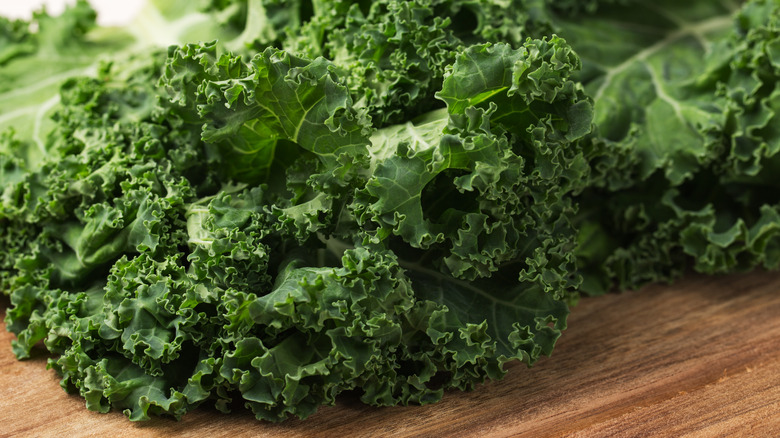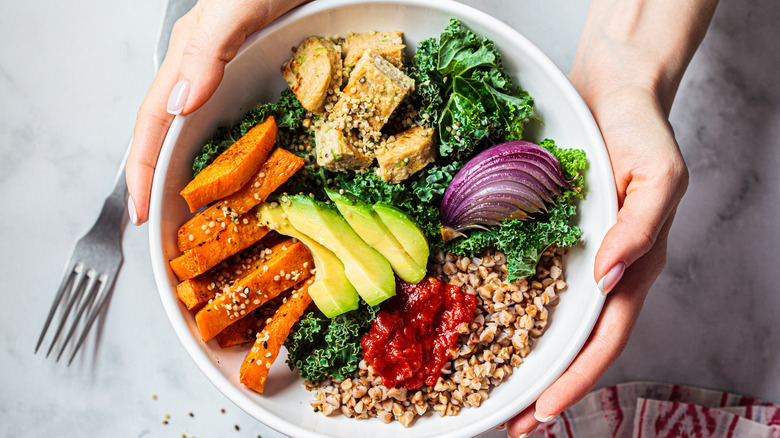Martha Stewart's Spoon Hack For Stripping Kale
If you're staring down a pile of long-stemmed greens like kale, have no fear. Mogul Martha Stewart herself has a kitchen hack to strip tender leaves from their crunchy middles. The entertaining expert uses a slotted spoon with drainage holes to prep the greens.
One quick tug and the ribs are gone. Stewart demonstrates the move on a pile of what's likely homegrown kale, but the same trick applies to spinach, as well as young Swiss chard, mustard greens, and collard greens. Depending on the size of your spoon and the size of your stems, you can strip tender herbs like cilantro and parsley. We suggest giving the technique a try with hearty rosemary, too.
@celebs Martha Stewart with an important cooking hack #fyp #celebs #cookinghacks
Stewart's seamless motion might take a little practice but will come in handy after a farmers market or garden haul. Some mature store-bought kale tends to have thicker stems that won't glide through a slotted spoon, but you'll see more variety in species and shapes when perusing local stands. A little trial and error will show you how to make the cooking hack work for you.
You don't have to ditch the stems
Yes, the stems take longer to cook than the leaves. But you don't have to ditch the fibrous leftovers if you want to get experimental. With a little extra planning, you can incorporate the middles into your meal and reduce food waste in the process.
If you're making a sauteed or braised dish using onions, peppers, and other slower-cooking vegetables, add the stems alongside them. They'll break down with other firm produce before you add and wilt the leaves. If you're grilling, try placing them in a vegetable basket and exposing them to smoky heat to elevate a vegetarian meal. Or, take another page from the culinary expert and use those stems in a green juice — like the one Martha Stewart drinks every morning.
For herbs, we suggest a different approach. Though parsley and cilantro are prized for their leaves and light texture, the aromatic centers can add an herbaceous touch to blended soups and sauces. Finely chopped, they're a good match for textured salads — like tabbouleh and fattoush — where the extra crunch blends right in. And if you're in a rush, stash the extras in a freezer bag with other vegetable scraps to flavor a future stock.
Cooking with kale and bitter greens
Over the last few years, kale cemented its status as a healthy and hearty vegetable. By now, many of our dining routines include iterations of massaged salads, doctored-up pestos, and braised greens and eggs. But, as Martha Stewart's cooking hack reminds us, there are plenty of other leaves deserving of kitchen love.
For those initially turned off by the trendy produce or the acrid taste of all things cruciferous, we suggest taking the opportunity to try again — and not just because they're good for you. According to a 2022 study published in Nutrients, brassica vegetables (like kale and other dark, leafy greens) can reduce inflammation and may prevent certain chronic diseases, like diabetes or heart disease. These vegetables, when prepared thoughtfully, taste delicious. There are seasoning solutions to help fix the bitter taste in collard greens that can help balance similarly challenging flavors in other cruciferous veg.
But before you pick up the salt, take a few extra steps after you strip the stems. Give the leaves a rinse before and after you've prepped them to shake the tart chemicals released during cutting. Better yet, a quick blanch and rinse, or a slow stew, can pull out more of the off-putting notes from leafy veg like kale. And add a big hit of acid when you're done to combat the bitterness in cooked and raw dishes. Delicious!



